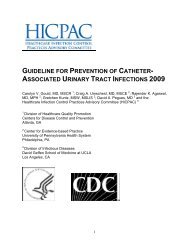SECT2.05 - Recommended Practices for Electrosurgery - Medline
SECT2.05 - Recommended Practices for Electrosurgery - Medline
SECT2.05 - Recommended Practices for Electrosurgery - Medline
- No tags were found...
Create successful ePaper yourself
Turn your PDF publications into a flip-book with our unique Google optimized e-Paper software.
RP: <strong>Electrosurgery</strong>I.f.subsequently activated. 1 Appropriate matchingand use of accessories specific to theESU minimizes this risk.Health care organizations should attempt tostandardize electrosurgical equipment usedwithin the facility.Equipment standardization reduces therisk of error. 18Recommendation IIThe ESU should be used in a manner that minimizesthe potential <strong>for</strong> injuries.Electrosurgical units are high-risk equipment. 1Potential complications of electrosurgery includepatient injuries, user injuries, fires, and electromagneticinterference with other medical equipmentand internal electronic devices. 2 <strong>Electrosurgery</strong>safety is heightened by adhering to good practices.18 Adverse events (eg, patient burns and fires)may be reduced by adhering to basic principles ofelectrosurgery safety. 15II.a.II.a.1.II.b.Instructions <strong>for</strong> ESU use, warranties, and amanual <strong>for</strong> maintenance and inspectionsshould be obtained from the manufacturerand be readily available to users. 2,19Equipment manuals assist in developingoperational, safety, and maintenance guidelines,as well as serve as a reference <strong>for</strong>appropriate use. 19Concise, clearly readable operatinginstructions specific <strong>for</strong> the deviceshould be on or attached to each ESU. 19Readily available instructions reducethe risk of operator error.The ESU should be securely mounted on atip-resistant cart or shelf and should not beused as a shelf or table.II.c. The ESU should be protected from liquids. 19Liquids entering the ESU can cause unintentionalactivation, device failure, or anelectrical hazard.II.c.1.II.c.2.Liquids should not be placed on top ofthe ESU.Foot pedal accessories should beencased in a clean, impervious coverwhen there is potential <strong>for</strong> fluid spillson the floor.II.d.II.e.II.f.II.f.1.II.f.2.II.f.3.II.f.4.Safety and warning alarms and activationindicators should be operational, audible,and visible at all times. 1,16-18,20Safety and warning alarms alert the operatorto potential electrode failure. 5 The indicatorsand alarms immediately alert the perioperativeteam when the ESU is activated. 2,18The ESU should be visually inspected andthe return electrode monitor tested accordingto manufacturer’s instructions be<strong>for</strong>e use. 19,20The ESU will sound an alarm and notactivate if the dispersive electrode isdisconnected. 2,20Settings should be based on the operator’spreference consistent with the intendedapplication and the manufacturer’s writteninstructions <strong>for</strong> patient size, active electrodetype, and return electrode placement.The ESU’s power output capability isdependent on multiple variables related tothe patient, generator, accessories, and theprocedure.The circulating nurse should confirmthe power settings with the operatorbe<strong>for</strong>e activation of the ESU.The ESU should be operated at the lowesteffective power setting needed toachieve the desired tissue effect. 2,18,20-22The likelihood of arcing and capacitivecoupling are increased when higherthan necessary voltages are used. 22If the operator requests a continualincrease in power, personnel shouldcheck the entire ESU and accessories circuit<strong>for</strong> adequate placement of the dispersiveelectrode and cord connections. 18,19,23Prolonged current at high power cancause patient injury. Common causesof ineffective coagulation and cuttingare high impedance at the dispersiveelectrode, poor contact between thedispersive electrode and the patient,and use of an electrolytic irrigation/distention solution. 23,24The electrode tip should be visuallyinspected be<strong>for</strong>e each use and replacedif damaged.A damaged active electrode tip maycause a buildup of eschar, creating100Equipment and Product Safety2012 Perioperative Standards and <strong>Recommended</strong> <strong>Practices</strong>
















